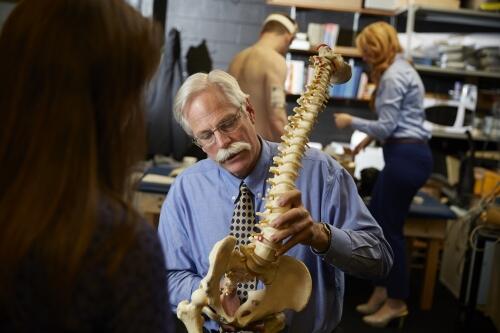
New findings will improve the sex lives of women with back problems
Newly published findings from the University of Waterloo are giving women with bad backs renewed hope for better sex lives

Newly published findings from the University of Waterloo are giving women with bad backs renewed hope for better sex lives
By Media RelationsThe findings—part of the first-ever study to document how the spine moves during sex—outline which sex positions are best for women suffering from different types of low back pain. The new recommendations follow on the heels of comparable guidelines for men released last month.
Published in European Spine Journal, the female findings debunk the popular belief that spooning—where couples lie on their sides curled in the same direction—is the best sex position for all women with low back pain.
“Traditionally, spooning was recommended by physicians to all individuals with back pain because it was thought to reduce nerve tension and load on the tissues,” said Natalie Sidorkewicz, the PhD candidate at Waterloo who led the study. “But when we examined spine motion and muscle activity, we found that spooning can actually be one of the worst positions for certain types of back pain.”
The pioneering research combined infrared and electromagnetic motion capture systems, like those used by filmmakers for full computer graphic character animation, to track how 10 couples’ spines moved when attempting five common sex positions. The findings were used to create an atlas, or illustrated set of guidelines that recommends different sex positions based on what movements trigger a patient’s pain.
The atlas suggests that women who are extension-intolerant, meaning those whose back pain is made worse by arching their backs or lying on their stomachs, for example, replace spooning with the missionary position. Adding a low-back support, such as a pillow, can also help keep the spine in a more neutral position. For women who are flexion-intolerant, typically those whose back pain is made worse by touching their toes or sitting for long periods of time, the atlas recommends spooning or doggy-style sex where the woman is supporting her upper body with her hands, not her elbows.

Professor Stuart McGill demonstrates the motion of the spine during sex. ![]()
“What we know now is that sex positions that are suitable for one type of back pain are not appropriate for another kind of pain,” said Sidorkewicz. “These guidelines have the potential to improve quality of life—and love life—for many couples.”
According to Statistics Canada, four of every five people will experience at least one episode of disabling low-back pain in their lifetime. Up to 84 per cent of men with low-back pain and 73 per cent of women report a significant decrease in the frequency of intercourse when suffering back pain.
“Primary care physicians report it is common for couples to seek their advice regarding how to manage their back pain during and after sex. Many couples will remain celibate because the pain resulting from one night of lovemaking lasts months,” said Professor Stuart McGill, of the Faculty of Applied Health Sciences at Waterloo. “Now doctors have solid science to guide their recommendations.”
The next phase of the study will involve recruiting patients with different categories of back and hip pain, as well as additional sex positions, to further develop the recommendations.

Read more
The University of Waterloo is home to Canada’s first Christmas tree lab and is partnering with the Christmas Tree Farmers of Ontario to advance sustainable initiatives

Read more
Funding supports a range of projects from sustainable 3D printed materials to 6G network innovations and improving the electric automotive industry

Read more
Waterloo professor Kelsey Leonard shares insights on the environmental impact of Christmas trees
The University of Waterloo acknowledges that much of our work takes place on the traditional territory of the Neutral, Anishinaabeg, and Haudenosaunee peoples. Our main campus is situated on the Haldimand Tract, the land granted to the Six Nations that includes six miles on each side of the Grand River. Our active work toward reconciliation takes place across our campuses through research, learning, teaching, and community building, and is co-ordinated within the Office of Indigenous Relations.
Select 'Accept all' to agree and continue. You consent to our cookies if you continue to use this website.